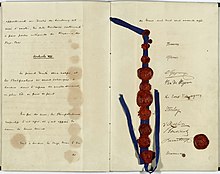Treaty of London (1867)

Signatures on the 1867 Treaty of London.
|
|
| Type | multilateral treaty |
|---|---|
| Signed | 11 May 1867 |
| Location | London, England, UK |
| Original signatories |
Austria, Belgium, France, Italy, Luxembourg, Netherlands, Prussia, Russia, UK |
| Ratifiers | Austria, Belgium, France, Italy, Luxembourg, Netherlands, Prussia, Russia, UK |
The Treaty of London (French: Traité de Londres), often called the Second Treaty of London after the 1839 Treaty, was an international treaty signed on 11 May 1867. Agreed to in the aftermath of the Austro-Prussian War and the Luxembourg Crisis, it had wide-reaching consequences for Luxembourg and for relations between Europe's Great Powers.
The immediate effect of the treaty, established in Article I, was the reaffirmation of the personal union between the Netherlands and Luxembourg under the House of Orange-Nassau. It lasted until 1890, when a woman (Queen Wilhelmina) ascended to the Dutch throne. As at that time the Salic law was still in effect in Luxembourg, she could not become Grand Duchess of Luxembourg.
It was the older branch of the House of Nassau (Nassau-Weilburg, now called Luxembourg-Nassau) that inherited that dignity, giving Luxembourg its own exclusive dynasty.
The Luxembourg Crisis had erupted after French Emperor Napoleon III attempted to buy Luxembourg from the Dutch King William III. Consequently, maintaining Dutch dominance over the de jure independent Luxembourg, free from French interference, was of paramount importance to Prussia.
The neutrality of Luxembourg, established by the First Treaty of London, was also reaffirmed. The parties that did not sign the earlier treaty were to become guarantors of Luxembourg's neutrality (an exception was Belgium, which was, itself, bound to neutrality).
...
Wikipedia
